Tagged With ‘sandalwood’
Louis Vuitton
Au Hasard
2 July, 2018
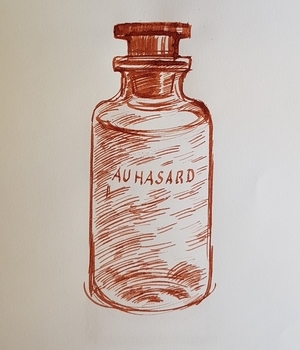 Almost alone among major luxury brands, Louis Vuitton did not have a single perfume to its name until 2016. That was the year when – after four years of rumours and the appointment, in 2011, of Jacques Cavallier as the company’s in-house perfumer – the company released seven scents in smart but simple bottles designed by Marc Newson. Floral and feminine in style, they were excellent examples of their kind.
Almost alone among major luxury brands, Louis Vuitton did not have a single perfume to its name until 2016. That was the year when – after four years of rumours and the appointment, in 2011, of Jacques Cavallier as the company’s in-house perfumer – the company released seven scents in smart but simple bottles designed by Marc Newson. Floral and feminine in style, they were excellent examples of their kind.
Two years on Vuitton and Cavallier have turned their attention to the male sex, with ‘Les Parfums’ for men – five new fragrances that, in their words, ‘pay homage to the adventurer on a quest for self-revelation’. Sensibly they’ve kept the same design for the bottles and packaging, with only subtle changes: each eau de parfum is a different pale colour, while the black magnetic bottle stoppers are stamped with the silver LV logo.
Sur la Route is Vuitton’s take on eau de cologne, with the evanescent but always refreshing scent of Calabrian lemon – specifically the zingy fruit and the bitter-fresh pulp around it – extended with a special grade of cedar and a touch of bergamot. The green note of freshly cut grass is balanced with the softer smell of Peruvian balsam which, Cavallier says, ‘includes the freshness of citrus and spicy notes of pink peppercorn and nutmeg’.
Orage uses the sexy, earthy smell of patchouli and pairs it with long-lasting top-quality iris, which adds a plush note of luxury to any scent. Though it’s not as stormy as its name suggests (or as woody as the press release describes it), Orage does have a hint of the green freshness that follows a summer downpour in the countryside.
L’Immensité has, perhaps, the most in common with the general run of men’s ‘sports’ fragrances such as Dior’s Sauvage, mainly because it has an overdose of the synthetic molecule Ambroxan. Some people love its mineral, slightly peppery note, but it reminds others of an electrical fire. Here, it’s framed by bitter grapefruit, ginger and labdanum.
For lovers of gourmand perfumes, there’s Nouveau Monde, which uses an extract of natural cocoa from the former French colony of Ivory Coast in combination with oud to create a rich and exotic scent with a touch of saffron underneath. Despite being an eau de parfum strength, it’s restrained rather than overpowering, like all the fragrances in the range.
My personal favourite, though, is Au Hazard, which takes another classic ingredient of men’s perfumery, sandalwood, using a sustainably cultivated variety from Sri Lanka. It’s a gentle, slightly spicy fragrance, with hints of cardamom and ambrette seeds, which would smell equally comfortable as a day or evening scent.
Frédéric Malle
Géranium pour Monsieur
28 November, 2016
 The world is full of fresh smells, but only a few of them are widely used in perfumery – mainly the sharp but fruity smells of citrus, which give eau-de-colognes their uplifting zing. The scents of mint or pine-needles are equally fresh and invigorating, yet few people want to smell of either, for the simple reason that mint is so strongly associated with toothpaste, and pine with household cleaning products. It’s a brave perfumer who attempts to use either of them in a fragrance, but Géranium pour Monsieur is a brilliant demonstration of how it can be done.
The world is full of fresh smells, but only a few of them are widely used in perfumery – mainly the sharp but fruity smells of citrus, which give eau-de-colognes their uplifting zing. The scents of mint or pine-needles are equally fresh and invigorating, yet few people want to smell of either, for the simple reason that mint is so strongly associated with toothpaste, and pine with household cleaning products. It’s a brave perfumer who attempts to use either of them in a fragrance, but Géranium pour Monsieur is a brilliant demonstration of how it can be done.
Created by Dominique Ropion for Frédéric Malle in 2009, this is a wonderful alternative to classic colognes, and it also offers something that colognes don’t have: a freshness that lasts not just for a few minutes or an hour or so, but almost all day long. Ropion has cleverly extended the refreshing scent of mint by mixing it with geranium (or rather pelargonium) oil, which has a minty side to it but lasts much longer than mint alone, and a spicy side that is emphasised here with the addition of aniseed, clove oil and cinnamon.
Like all the perfumes that Malle has commissioned for his Editions de Parfums range, this is a rich, complex scent, and its freshness is underlaid with smooth but luxurious ingredients like sandalwood, long-lasting synthetic white musks, and smaller amounts of incense and resinous benzoin. I think it’s a masterpiece, and a fine addition to the wardrobe of any well-dressed man.
Lalique
Encre Noire à l’Extrême
18 November, 2016
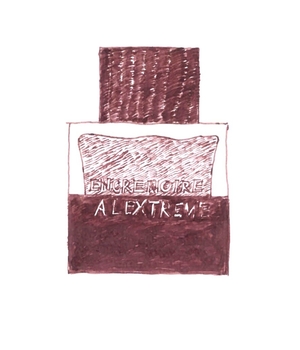 Lalique has been associated with perfume since 1907, when its founder, René Lalique, began to produce alluring glass bottles for the prodigiously entrepreneurial French perfumer François Coty. But it wasn’t until 1992 that the company launched a perfume of its own with Lalique de Lalique.
Lalique has been associated with perfume since 1907, when its founder, René Lalique, began to produce alluring glass bottles for the prodigiously entrepreneurial French perfumer François Coty. But it wasn’t until 1992 that the company launched a perfume of its own with Lalique de Lalique.
Encre Noire – literally ‘black ink’ – was released in 2006, and was quickly hailed as one of the best vetiver scents around. Created by the talented perfumer Nathalie Lorson from the Swiss fragrance-and-flavour firm Firmenich, it blends good-quality vetiver (whose earthy, slightly bitter smell comes from the roots of a tropical grass) with the woody notes of cypress and a long-lasting synthetic called Cashmeran, whose effect is as plush as its name.
Though Encre Noire is still available, and presumably a steady seller, Lalique has celebrated its 10th anniversary by launching a slightly more powerful, punchy version called Encre Noire à l’Extrême. Created again by Nathalie Lorson, the new perfume blends two different vetivers, one from Haiti and the from Java, and adds touches of iris, incense, sandalwood and patchouli.
If rather stronger and heavier than the earlier Encre Noire, it’s still a very attractive fragrance, and while Lalique claims that Encre Nore à l’Extrême ‘redefines masculinity’, we feel that it would smell equally appealing on a man or a woman. Think ink.
Guerlain
Derby
21 August, 2015
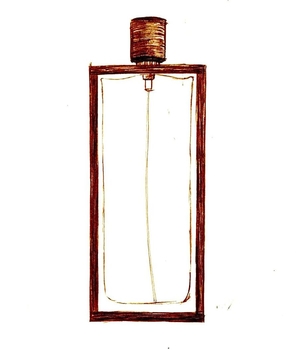 What a great perfume this is. Rich and complex yet totally wearable, Derby smells of old-fashioned luxury and style. It’s the kind of perfume that should have been name-checked in The Great Gatsby (surely the worst-written major novel of the 20th century), and yet it was first launched as recently as 1985, when electropop ruled the airwaves and shoulder-pads the size of aircraft carriers filled the pages of the fashion magazines.
What a great perfume this is. Rich and complex yet totally wearable, Derby smells of old-fashioned luxury and style. It’s the kind of perfume that should have been name-checked in The Great Gatsby (surely the worst-written major novel of the 20th century), and yet it was first launched as recently as 1985, when electropop ruled the airwaves and shoulder-pads the size of aircraft carriers filled the pages of the fashion magazines.
It was created by Jean-Paul Guerlain, the last member of the family to run the brand and a great perfumer in his own right: his other triumphs include Habit Rouge, Chamade and the fantastic Vétiver. Derby smells like crushed aromatic herbs when you first spray it on: rosemary and lavender with a hint of mint, but mixed with more exotic things like patchouli and sandalwood. Mace and pepper add a tiny touch of spice, while oakmoss, leather and vetiver give it extra depth and staying-power. After a while it smells more leathery than anything else, though still with herbs and spices mixed in – the scent of a Greek mountainside in summer.
For a long time Derby was quite hard to track down, which added to its mystique, but in 2005 Guerlain relaunched it as part of its Parisiens collection, at which point is was probably (though of course perfume companies never tell you these things) slightly ‘tweaked’ to change some of its ingredients (such as oakmoss) to comply with EU legislation. In 2011 it was repackaged in what I think is a rather cheap-looking balsawood frame, and its price went up as well: today it’s one of Guerlain’s most expensive fragrances, which I think is a shame, as it deserves to be widely worn.
Christian Dior
Jules
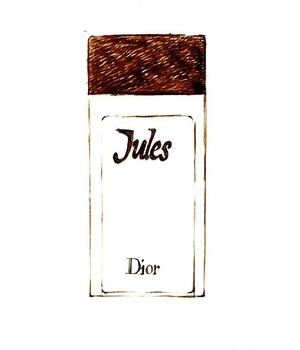 Sage isn’t everyone’s favourite herb, though turkey stuffing wouldn’t the same without it. It’s used less often in perfumery than in cooking, but Jules shows what a great ingredient it can be in the hands of a brilliant perfumer.
Sage isn’t everyone’s favourite herb, though turkey stuffing wouldn’t the same without it. It’s used less often in perfumery than in cooking, but Jules shows what a great ingredient it can be in the hands of a brilliant perfumer.
The ‘nose’ in this case was Jean Martel, who worked for the French fragrance company Givaudan in the 1970s and 1980s and deserves to be far better known, not least because he also created that 1970s classic, Paco Rabanne for Men.
Jules was launched in 1980, with a brilliant advertising campaign featuring posters by René Gruau, arguably the greatest fashion illustrator of the last century, which helped the first bottles sell out in record time. Martel combined sage (which has a slightly catty smell) with cedar and other things like wormwood, lavender and bergamot. To me the result smells like sage and slightly peppery leather, though there’s a long list of other ingredients, including cumin, sandalwood, oakmoss, jasmine, musk and rose.
Despite its initial success, Jules has since been overshadowed by the success of Kouros, which was launched the following year. Created for Yves Saint Laurent by the brilliant Pierre (Cool Water) Bourdon, Kouros shares Jules’ clean / dirty / sexy character, and both scents belong to the same fragrance ‘family’, the fougères – a style of perfumes, usually aimed at men, based on a combination of lavender and coumarin (originally derived from tonka beans but usually synthesised).
Of course, Kouros’ ongoing popularity may be because it’s inherently superior to Jules, but actually I think it’s more to do with the fact that over the years Kouros has benefited from regular advertising, while Dior seems to have forgotten that Jules ever existed, which I think is a terrible shame.
To make matters worse, while you can buy Kouros pretty much anywhere, Jules has become ridiculously hard to find: I don’t know anywhere in the UK that sells it, and even in Paris the only place that seems to stock it is the department store Bon Marché, though you can buy it from Dior’s French website. Given Dior’s apparent lack of interest, it’s a wonder it hasn’t been discontinued, but I’m glad it’s still on sale, even if it’s now a rarity.
I can only hope that one day they decide to invest in promoting it again and making it available to all – but in the meantime if you want something special that very few other people will have, get over to Bon Marché.
Annick Goutal
Eau de Monsieur
26 March, 2015
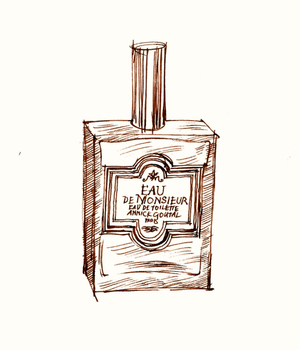 Mention the name Annick Goutal and the first scent that springs to mind is Eau d’Hadrien, the intensely lemony, slightly hair-sprayish scent that was launched in 1981 and went on to become the company’s best-seller.
Mention the name Annick Goutal and the first scent that springs to mind is Eau d’Hadrien, the intensely lemony, slightly hair-sprayish scent that was launched in 1981 and went on to become the company’s best-seller.
But before Eau d’Hadrien came Eau de Monsieur. Launched in 1980, discontinued for a while and then relaunched in 2013, it shares its lemony, eau de cologne-like zest with Eau d’Hadrien, but it’s an altogether quieter, softer fragrance.
Eau de Monsieur, like Eau d’Hadrien, is based around the zesty, zingy smell of lemons and the slightly pear-drop-lemony sweetness of lemon verbena (extracted from the leaves of a straggly South American shrub).
But while that’s pretty much the start and the finish of Eau d’Hadrien, that initial burst of sharp sweet freshness quickly fades to reveal what smells a bit like a sun-drenched Greek mountainside underneath – that scent of crushed thyme, cistus leaves and lavender, which in this case has an added touch of helichrysum, that strong-smelling everlasting flower that the French call immortelle.
Immortelle isn’t a scent that everybody loves: to me it has the richness of brandy and Christmas pudding and crackling pine-log fires, but to other people it has a medicinal TCP smell, which isn’t something you necessarily want in a perfume.
In Goutal’s fantastic Sables, released a few years later in 1985, immortelle is the main ingredient, but in Eau de Monsieur it’s used in moderation to give a subtle background sweetness. According to the list of ingredients on the Annick Goutal website, it also includes patchouli and sandalwood, which add a bit of their gentle warm woodiness to the mix, and there’s a little bit of bitterness too, which other writers have ascribed to that classic men’s-fragrance ingredient, vetiver.
It’s not, perhaps, the most original perfume out there, and it’s disappointing to discover that it only last an hour or so on the skin, but Eau de Monsieur is classy, attractive, natural-smelling and easy to wear, which is a lot more than you can say for the majority of men’s fragrances.
Ramón Monegal
Dry Wood
2 March, 2015
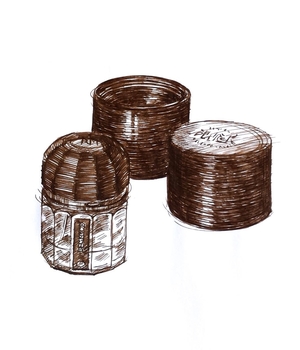 The world of perfume is full of great stories – some of them true, others completely bogus or quietly tweaked by fiendish marketeers. The story of Ramón Monegal is one of the better ones, and it’s also more interesting than most. The nice thing is that it has a happy ending too.
The world of perfume is full of great stories – some of them true, others completely bogus or quietly tweaked by fiendish marketeers. The story of Ramón Monegal is one of the better ones, and it’s also more interesting than most. The nice thing is that it has a happy ending too.
Monegal’s great-grandfather founded Myrurgia, which during the twentieth century became the best-known perfume brand in Spain. Ramón joined the business in 1972, training at Firmenich in Geneva and in Paris with the famous perfumer Pierre Bourdon (creator of Davidoff’s Cool Water and Serge Lutens’ Feminité du Bois).
Ramón created his first perfume for Myrurgia in 1979, but he also went on to develop scents for other brands, from Adolfo Dominguez to Inès de la Fressange. He eventually became vice-president of the family company, but in 2000 it was sold to Puig, the giant Barcelona-based fragrance-and-fashion group, which owns everything from Jean-Paul Gaultier to Penhaligon’s and L’Artisan Parfumeur.
The transition from owner to employee is surely always a difficult one, and though Monegal was appointed development director for the group’s fragrance brands, it must have hurt when, in 2007, Puig closed Myrurgia down. Monegal left the same year, but in 2010 he launched his own brand, and in 2014 he made a remarkable comeback by releasing fourteen new fragrances in one go. All the ones I’ve smelled so far are interesting and unusual, and Dry Wood is no exception.
It’s been described as a ‘sharp sandalwood’, but it also reminds me of a top-quality men’s aftershave from the 1970s, with hints of cedar and pine as well as sandalwood; if you remember the old ‘things happen after a Badedas bath’ adverts you’ll know the kind of thing I mean. It has great staying-power, and after a while smells woodier than it does to start with, though still with a touch of pine and turpentine.
Like all the perfumes in the range, Dry Wood comes in attractively luxurious packaging, also designed by Monegal. The chunky twelve-sided ‘inkwell’ bottles, with their flip-up black domed caps, are apparently inspired by his love of literature, and are contained in black Bakelite tubes, which screw closed in a very satisfying way. Perhaps it’s not surprising that these perfumes are expensive, at £130 for just 50ml (or $160 in the States).
The only problem at the moment is buying them: currently they’re only available from Harrods in the UK or Nieman Marcus in the US, which means they’re not going to get as wide an exposure as I think they deserve. Still, they’re well worth tracking down if you have the dedication (and the cash).
Cartier
Déclaration d’un Soir
18 February, 2015
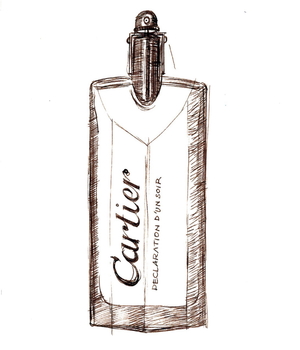 ‘This new masculine scent sensation is perfect for grand evenings – an impulsive perfume capable of sweeping away taboos, brazenly daring to say the unsayable and conjuring up moments of unforgettable bliss. Like a magic wand, it unleashes the emotions and feelings…’
‘This new masculine scent sensation is perfect for grand evenings – an impulsive perfume capable of sweeping away taboos, brazenly daring to say the unsayable and conjuring up moments of unforgettable bliss. Like a magic wand, it unleashes the emotions and feelings…’
Yes, it’s perfume bollocks time again, though at least this time at least it’s for rather a nice scent: Cartier’s Déclaration d’un Soir. Launched in 2012, it was created by their in-house perfumer, Mathilde Laurent, and like Cartier’s earlier (and now quietly discontinued) Must de Cartier Pour Homme, it has a surprising amount of rose in it for a men’s fragrance.
But don’t let that put you off: just as there’s no reason (in the right context) that a man can’t wear pink, so there’s no reason that the scent of rose, if it’s mixed with the right ingredients, has to smell floral and girly. That’s the brilliant trick of Serge Lutens’ Féminité du Bois, which – figuratively speaking – puts the smell of rose in a rather masculine cedar box.
Déclaration d’un Soir isn’t as striking as Feminité du Bois, but it’s got an appealingly plush feeling, with a slight (and not unpleasant) hint of damp soil. Déclaration d’un Soir does have a woody side to it, too, but in this case Mathilde Laurent has used sandalwood, which adds its own sweet spiciness to nutmeg, cumin and pepper.
(Incidentally, what is it about recent men’s perfumes and pepper? Virtually every ‘mainstream’ scent I’ve smelled in the last few years has reeks of the stuff, as if some secret society had ordained that all men’s perfumes had to include masses of pepper. I guess it’s just a fashion, but it makes most of them smell about as subtle and appealing as a pepper spray or a short-circuited computer. Luckily the pepper in Déclaration d’un Soir is pretty restrained.)
It’s a nice scent, as I say: warm, rich, long-lasting and – to my mind anyway – completely unisex. The only shame is that it comes in such a fussily designed bottle (the same as Cartier’s best-selling Déclaration), with its silly clip to stop you depressing the spray-top instead of a cap.
Far more of a shame, though, is the fact that Cartier have given up on Must de Cartier Pour Homme, which I liked even more and which came in that rarest thing: a really beautifully designed bottle. But that’s the perfume industry for you: a triumph of economics over aesthetics.
Tom Daxon
Sicilian Wood
11 January, 2015
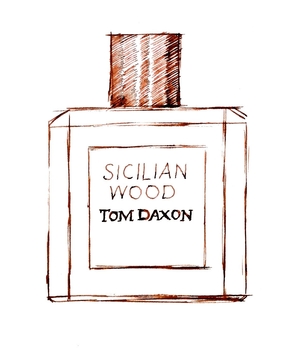 I had high hopes of Sicilian Wood. Tom Daxon launched his perfume business in March 2013 at the age of 25, and has quickly gained a lot of fans. I’m not surprised, as he looks like a nice chap and he should know his stuff: his mother, Dale Daxon Bowers, was trained as a chemist and worked for Mary Quant cosmetics before becoming creative director of Molton Brown, so you could say that Tom grew up in the fragrance business.
I had high hopes of Sicilian Wood. Tom Daxon launched his perfume business in March 2013 at the age of 25, and has quickly gained a lot of fans. I’m not surprised, as he looks like a nice chap and he should know his stuff: his mother, Dale Daxon Bowers, was trained as a chemist and worked for Mary Quant cosmetics before becoming creative director of Molton Brown, so you could say that Tom grew up in the fragrance business.
He’s started out with a small range of nine different perfumes, and as you’d hope given his background they’re outstandingly well designed and packaged, with sharp typefaces, smart faceted bottles and attractive boxes cleverly secured with criss-crossing black ribbons.
So far so good. The only trouble is, try as I might I just can’t get to like the perfume inside.
Daxon compares Sicilian Wood with ‘a citrus grove warming in the sun… [with] an effervescent, hyper-real citrus top note [that] settles into a base of seductive woods.’ He’s also described it as ‘a budget-less woody citrus [that] will prove a revelation to anyone left underwhelmed by all the bland versions out there.’
I certainly get the citrus, and the warmth, which emerges from a mix of (among other things) cardamom, guaiac wood, jasmine, cedar and sandalwood. But Sicilian Wood also has to me an unsettling, slightly sickly, somehow faintly chemical smell, which it shares with so many men’s fragrances on the market (especially so-called ‘sports’ scents) that I call it cheapone: the very opposite of ‘budget-less’, in other words.
Whatever it is, it spoils this perfume for me, which is a shame, as I’d really like to like it, not least because it was created by Carla Chabert and her father Jacques, who was once assistant to the perfumer Henri Robert at Chanel, and is said to have had a hand in Chanel’s classic Cristalle. Time to explore some of the other perfumes in the range.
Chanel
Antaeus
8 December, 2014
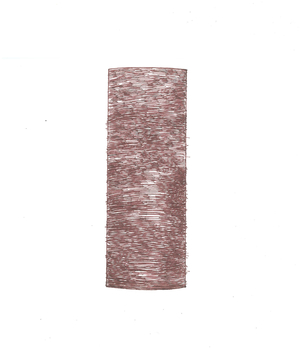 When I first started thinking about The Sniff Box, I wondered how I could make it look different from other perfume blogs. I knew I’d have no problem with the overall look, thanks to my super-talented friend, Leanda Ryan, whose design perfectly reflects the idea of ‘perfume in plain English’.
When I first started thinking about The Sniff Box, I wondered how I could make it look different from other perfume blogs. I knew I’d have no problem with the overall look, thanks to my super-talented friend, Leanda Ryan, whose design perfectly reflects the idea of ‘perfume in plain English’.
But illustrating individual perfumes is a problem, as you’ll gather if you look at other perfume sites on the interweb. The obvious thing to do is to use a ‘pack shot’, generally supplied by the brand in question: it’s what the brands like as that’s how they want you to see their scent, but how many times do you want to see the same cheesy photograph?
The trouble is, if you don’t use a photo of the bottle, what can you use instead? How do you illustrate something you can smell but can’t actually see? It’s interesting to check out what other people come up with, but given that few bloggers can afford to commission photography or illustration, they’re generally stuck with stock shots of things like perfume ingredients – a sprig of lavender, say, or a twist of lemon – which are as cheesy as the pack shots they’re trying to avoid.
It took a while, but finally it struck me: since I can draw, after a fashion, why not draw my own illustrations? And that’s how I began.
All of which is a roundabout way of saying that, when I was trying to draw my bottle of Antaeus this morning, it gradually dawned on me that it is one of the most beautiful perfume bottles I know. It’s also one of the simplest: a tall, square, black-glass container that, if you took away the classy sans-serif Chanel lettering, would bear a more-than-passing resemblance to sinister monolith in 2001: A Space Odyssey.
Designed (or at least commissioned) by Chanel’s long-standing artistic director, Jacques Helleu, and launched in 1981, Antaeus was a kind of dark-side twin to the brand’s only other men’s fragrance at that time, Pour Monsieur (launched way back in 1955). Their bottles may be almost identical in shape, but Pour Monsieur is as cool and transparent as Antaeus is brooding and mysterious, and that reflects the fact that they’re very different scents.
Pour Monsieur is a refined, impeccably discreet fragrance: perfect in its way but perhaps (dare one whisper it?) just a tiny bit dull. Antaeus, by contrast, is a dark sexy scent that was launched just as the disco era crashed and burned: the same year Ian Schrager and Steve Rubell sold out of Studio 54 and the big disease with a little name first reared its ugly head.
Antaeus (the scent) was created by Chanel’s much-fêted in-house perfumer, Jacques Polge, in collaboration with François Damachy, now head of fragrance at Dior). As suggestive as Pour Monsieur is safe, its sexiness comes from castoreum, derived from a secretion extracted from beaver wee (I kid you not), which despite its revolting origins becomes, after careful treatment, a potent perfume ingredient, with its musky, leathery smell.
It’s a warm, slightly spicy leather scent, with a lot of Mediterranean herbs, most notably clary sage and thyme, that most of us would probably associate with hot, rocky mountainsides in southern France and Greece. My nose isn’t yet sensitive enough to identify them, but it also apparently contains labdanum (derived from two different species of Cistus, another Mediterranean shrub), as well as sandalwood and patchouli, which presumably add to the slightly hippyish warmth of the scent.
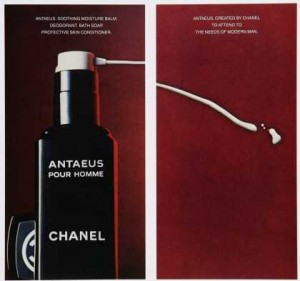 Antaeus became a big best-seller in the early 1980s initially, it seems, among gay men, and with its hints of sex and leather it’s easy to see why. Chanel itself tapped into this trend in 1983 with a delightfully pervy advert (pictured), whose subtext I can leave to your imagination.
Antaeus became a big best-seller in the early 1980s initially, it seems, among gay men, and with its hints of sex and leather it’s easy to see why. Chanel itself tapped into this trend in 1983 with a delightfully pervy advert (pictured), whose subtext I can leave to your imagination.
But gay men, as we’ve often been told, are classic early adopters, and these days Antaeus is just as likely to attract anyone who enjoys a rich and complex scent. It’s long been one of my favourites, for its warmth and easy appeal, but I love its darker origins too: sex (and history) in a bottle.